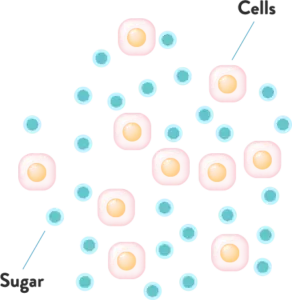
Moodie Foodie is a consummate consumer of gourmet food. She loves to eat, enjoying the taste of each ingredient, choosing only the ones that make her feel and look her very best. She knows that each time she eats pasta bolognese, she gets immediate energy. She knows that filet mignon makes her feel strong, and tiramisu gives her a wonderful buzz. Then, one day, Moodie Foodie eats her typical meal of pasta bolognese, but instead of giving her energy, it gives her a headache. The steak gives her heartburn, and the tiramisu puts her in bed for a week. She doesn’t know what’s going on, but she’s lost the ability to predict how specific nutrients will act, and she’s no longer able to process certain ingredients like she once could.
What is happening inside my body
Moodie Foodie’s story describes a hallmark of aging known as depletion of nutrient sensing. Several suggested pathways lead to depleted nutrient sensing, but the one most understood is insulin resistance. Usually, when a cell encounters sugar, the insulin released by the pancreas tells the cell to bring the sugar in and put it to work.


Moodie Foodie’s story describes a hallmark of aging known as depletion of nutrient sensing. Several suggested pathways lead to depleted nutrient sensing, but the one most understood is insulin resistance. Usually, when a cell encounters sugar, the insulin released by the pancreas tells the cell to bring the sugar in and put it to work.

In environments with a lot of inflammation and oxidative stress, cells stop being able to sense insulin, requiring higher and higher doses to communicate the same message to the cell. Over time, even the highest insulin doses don’t resonate, and sugar is stuck outside the cell, resulting in high blood sugar and diabetes.

In environments with a lot of inflammation and oxidative stress, cells stop being able to sense insulin, requiring higher and higher doses to communicate the same message to the cell. Over time, even the highest insulin doses don’t resonate, and sugar is stuck outside the cell, resulting in high blood sugar and diabetes.
Other protein pathways involved in nutrient sensing may also play roles in cell aging. The most talked-about pathways are the AMPK, mTOR, Sirtuins, and IGF1-GH (IIS) pathways. Much research is currently underway to see if it is possible to manipulate these nutrient signaling proteins to improve healthspan and lifespan.


Other protein pathways involved in nutrient sensing may also play roles in cell aging. The most talked-about pathways are the AMPK, mTOR, Sirtuins, and IGF1-GH (IIS) pathways. Much research is currently underway to see if it is possible to manipulate these nutrient signaling proteins to improve healthspan and lifespan.
Why this matters to you
Our body needs over 40 nutrients to stay healthy and for everything to work perfectly. If we can no longer recognize these nutrients, then we don’t use them as intended, and our health suffers because of it. One of the best parts of living is enjoying the food we eat. However, the types of food and nutrients we consume can profoundly affect our health and longevity.
This is why it’s crucial not only to watch what we eat, but also to make sure our bodies can process our food efficiently and effectively.
How the HOP Box Helps: Quercetin, Fisetin, and Curcumin can activate sirtuins and reduce inflammation, which may improve nutrient sensing to make Moodie Foodie a little less Moodie.









